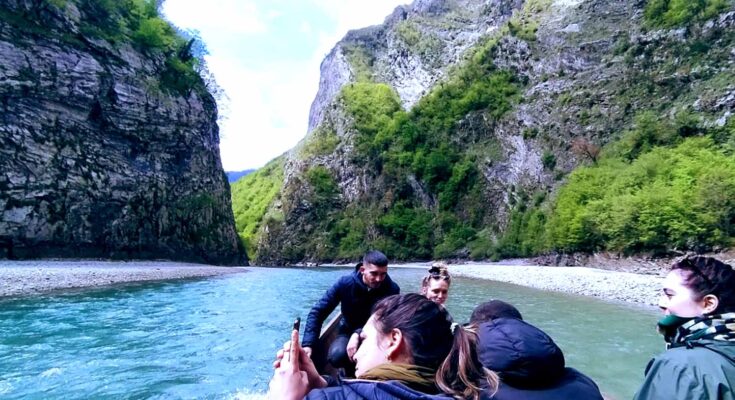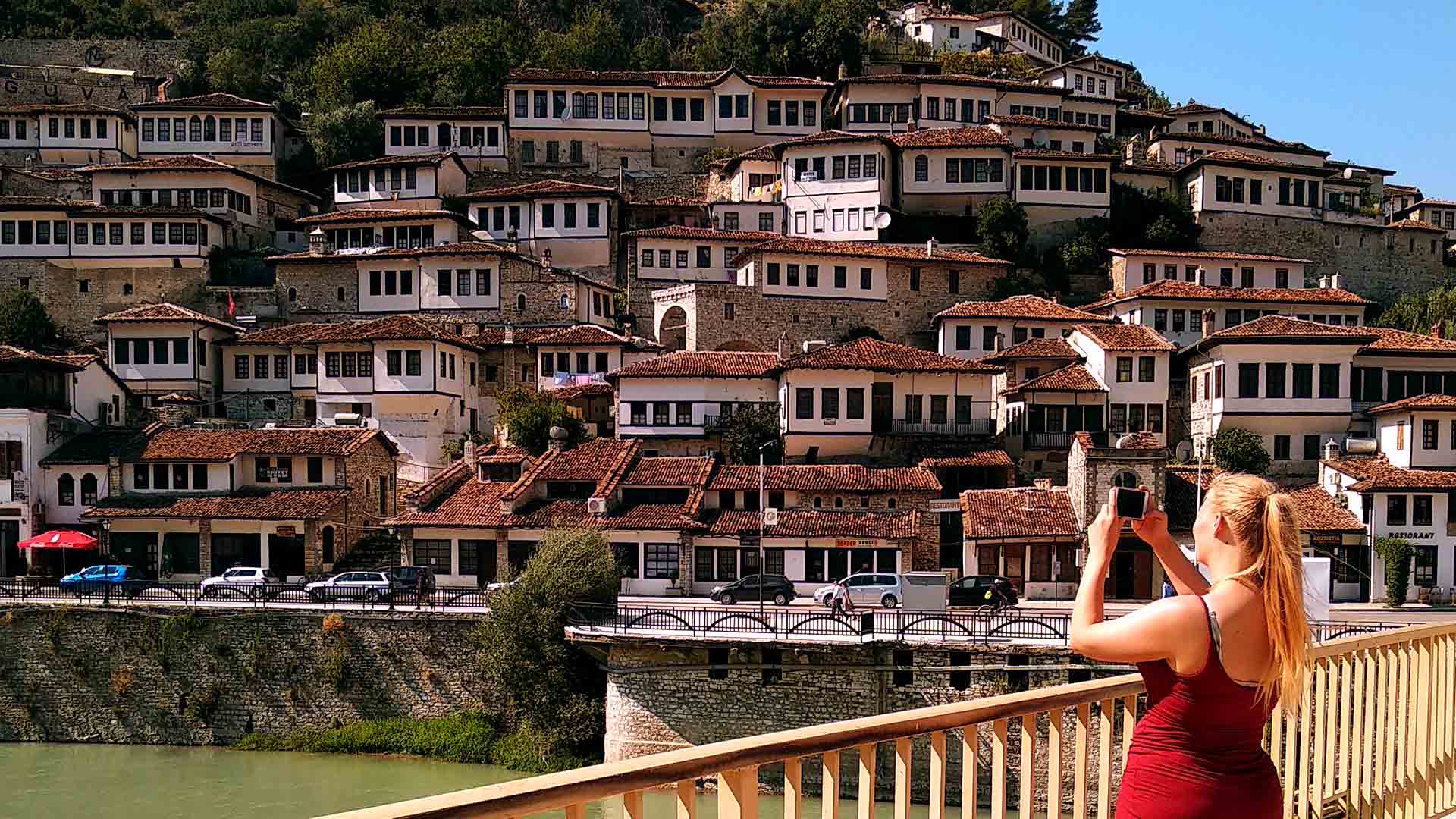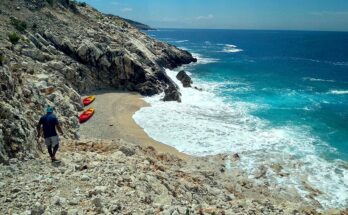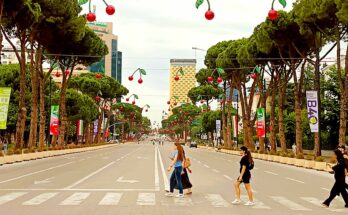The valley of the Shala River, located at the foot of the Albanian Alps in the North of Albania, in one of the branches of the water sources that supply Lake Koman, is one of the most popular tourist destinations for local and foreign tourists from all over the world. The entire area of the Drin coast, along Lake Koman, offers spectacular views, with narrow valleys lined with small agricultural plots, flourishing orchards, small villages, here and there alpine houses, waterfalls pouring from the mountains, rocks high that stick out at an angle of 90 degrees above the lake.
The Shala River Valley stretches from the heights of the Albanian Alps to the depths of Lake Koman, which is characterized by rugged mountain slopes and many water sources and waterfalls flowing on both sides of it. In recent years, for anyone looking to enjoy the amazing nature of the Albanian Alps, the Shala River is one of the main attractions of the trip to the North of Albania and/or the entire Albanian Alps.
The valley of the Shala River as part of the formation of the Albanian Alps and with it the Dinaric Alps, was created in an era between 50 – 100 million years ago, and today you can explore this amazing area, through the scenic paths of maintained for walking, hiking and why not enjoy a meal with organic products grown in the area or stay in one of the impressive hotels in the area.
The Shala River can be visited in one day, offered as part of specially tailored travel packages for those departing from Tirana, Shkodra or Valbona, or flying to destinations such as Tirana or Kukesi. However, if you get the chance to visit it longer, we recommend a stay of three days to a week, especially in summer.
Shkodra, Valbona and Tirana are three destinations that are known as gateways to the Shala River. In each of these destinations, you’ll find a diverse selection of boat tours in the Valley, but Valbona also has a lot to offer on its own. Other highly recommended cities are the cities near the Albanian Alps, Shkodra, Bajram Curri and Valbona, or a little further south and Tirana. These cities have extraordinary views and many tourist attractions as you may have seen on television channels or tourist portals, tabloids or well-known guide books around the world.
Our journey started early on one of the days of April this year, from the capital of Albania, Tirana. Since the weather was predicted to be unstable, we also took rain umbrellas with us and some jacquards suitable for such a trip. The sky looked cloudy but the April sun was bright and warm enough to feel like a spring day.
But as soon as we passed Qafalaç, as it is known by the residents of the area, the place where the roads for Puke and Koma branch off, we began to be convinced that winter had not left here yet. The wind and clouds proved that the cold and windy days of winter were still present there, and the sun suddenly disappeared among the clouds.
Captain Bardhi, as the residents of the area jokingly called him, welcomed us at the Komani quay. A man with a black moustache, short, taciturn but knew how to maneuver very well the motorboat we boarded, an iron boat with a motor, about 6 meters long. In addition to our group of Americans there was another group of 6 people, Albanians and French, a significant international mix at an hour of the day when there was very little movement there at the moment. But later, we realized that we were not the only ones in the area.
Cloudy weather was soon replaced by light rain and a strong wind blowing from the north. The umbrellas we had taken with us no longer worked. A strong wind with fine rain falling steeply, was the best combination to get soaked to the core. But as soon as the Isle of Peace appeared with the great cross raised on its top, the sky began to open and the sun came out again, the wind stopped and the weather suddenly changed to create the impression that we passed through a gate to another dimension. At the turn that leads to the Sala River, the weather warmed up even as we started to take off the jackets.
We had entered what is known as the Shala River. The gray rocks on both sides of the river clothed with sparse vegetation, ash on the lower level and pine on the higher, as they came out perpendicularly from the water, seemed to scratch the blue sky stained here and there by some white clouds. Large seagulls circled the boat from time to time. The silence of the valley was broken only by the sound of our boat’s engine, which pushed it along creating gentle waves that then crashed with a splash against the banks of the river. Although the water level had dropped about a meter, the surface of the river was still navigable.
We approached a characteristic wooden inn, the first on the right, a large wooden building with a long balcony overhanging the torques emerald colored water. A pair of stairs next to a jetty beautifully made of river stones, served to take a small boat that would enable us to pass through a gorge of the narrower valley. Various buildings and complexes began to appear during the journey along the river.
Shortly thereafter, the navigable surface of the water gave way to a strong stream of water running over a bed of white limestone carved by centuries of water flow in the area. The helmsman of the smaller boat knew the area and his job well, he just needed time to balance the boat and cope with the current with the throttle on the engine, to gain 2 meters in 10 minutes. After repeating this maneuver 2 times, we approached the bends and eddies of the river, which demanded more skill from the helmsman and more calmness and self-control from us tourists.
After we passed the cave of Leka, a destination and attraction, we immediately decided to stop on the way back, other hostels began to appear along with their facilities, hanging wooden bridges and a wooden structure that it served as a bar and counter during the summer for vacationers who participate in the many festivals organized during the summer. One of their facades was always embedded in the free-flowing and crystal-clear water of the river or on the bank near it.
We stopped at one of the guesthouses, a structure built by the river, with a terrace that also served as a restaurant, offering a linear view of the entire course of the river, an amazing landscape. The owner, a young middle-aged man, with a very welcoming and friendly expression offered us free drinks and some thin slices of smoked ham prepared by himself during the winter over his fireplace. After a while, the made-to-order dishes, cooked on the spot, meat and stir-fries, and various salads began to arrive.
After lunch, a zipline ride was unbeatable, from one coast to the other. A very safely constructed zipline with a manual mechanism, that is, the descent was in free fall and the return was made by relying on the strength of the man’s arm, a detail that added to the hilarity and was a lot of fun. Your return to where you started depended on the strength of the person gathering the steel shaft…
I must point out that the sun was blazing in that narrow gorge, like another world compared to the atmospheric weather conditions during the morning drive.
After a hearty greeting to the people standing there, we got back on the boat with our very friendly helmsman, and headed back to where we started our boat trip, the Koman terminal. On the way, several other tourists, families and young people, of different nationalities also boarded. It was a fantastic experience, where local residents help each other regardless of the original plan, a very positive feeling, where no one was left behind.
So, after a few hours of boat travel, fantastic views and food cooked in a special way, the end of our journey came, at the Koman terminal. There we took the cars and returned to Tirana.
A beautiful day not to be forgotten, that calls you to experience it again and again in every season of the year.



